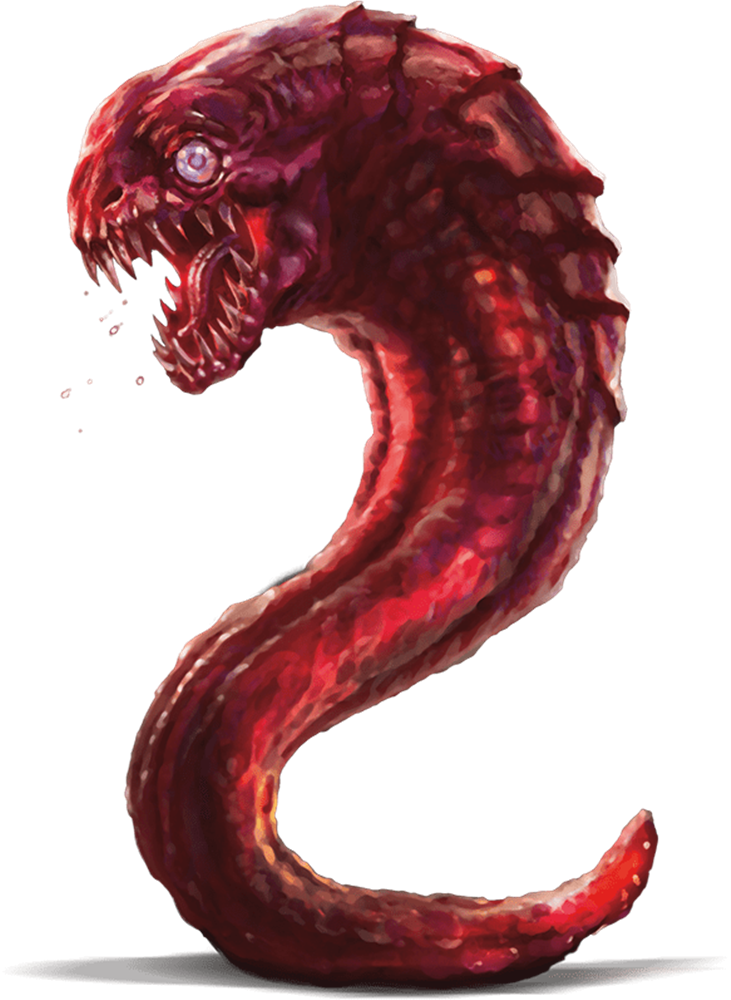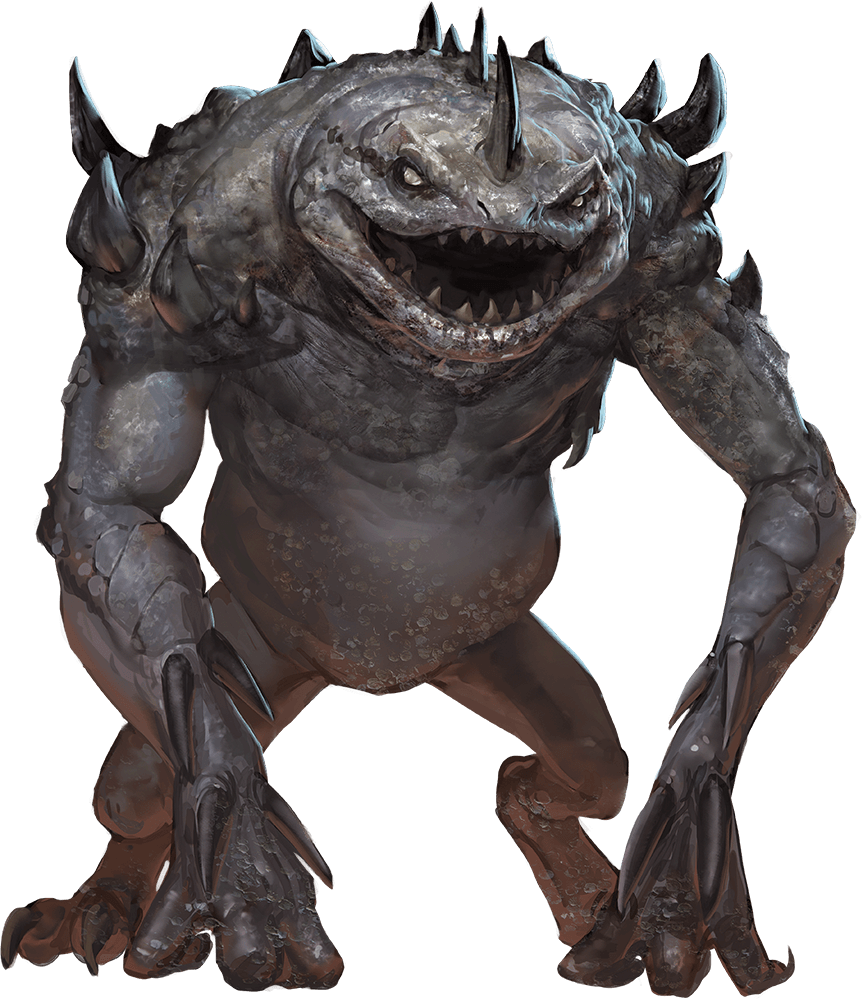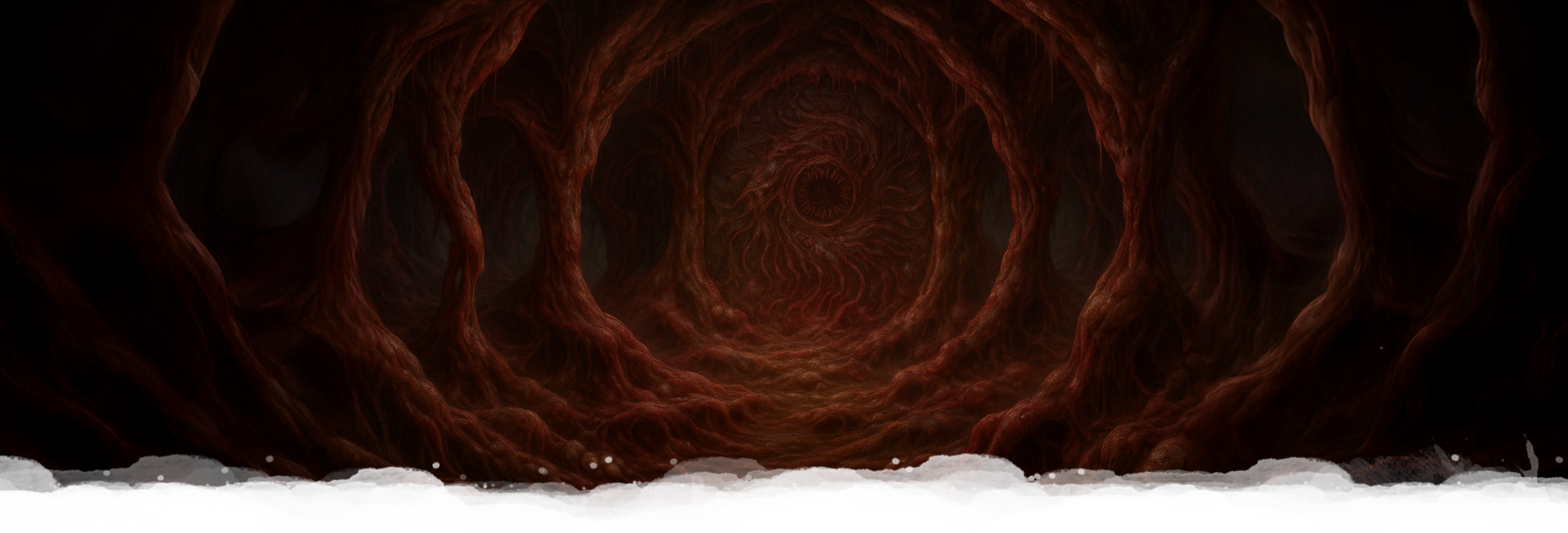Gorl'Boroth
Gorl’Boroth, known as The Ruinous Maw, is one of the five Old Gods—an apocalyptic force of rot, hunger, pestilence, and dissolution. While some deities weave fate, illuminate truth, or seduce the mind, Gorl’Boroth simply devours. It is not malicious in its consumption, nor cruel in its entropy. It simply is, and in being, it unmakes. Worship is irrelevant. Loyalty is incidental. To rot is to serve. To be consumed is to return to the spiral.
It is said that Gorl’Boroth has no fixed shape, only presence—a thunderhead of mouths, spiraling inward and inward without end, where gaping maws birth other maws, and everything is teeth and decay. Its flesh is a living plague: pitted, gangrenous muscle riddled with tunnels for vermin and pus-filled sacs that burst with crawling larvae. The Air around its manifestations smells of copper rot and fungal spores. Its cry is said to sound like ten thousand stomachs screaming in unison.
Among the most feared aspects of Gorl’Boroth is its endless fecundity. From the core of its mass emerge spore-sacs, womb-blisters, and cystic nodes that swell with parasitic spawn—living plague-things born to spread infection and hunger. These offspring—Slaadi, chaos-worms, or other mindless vectors—carry within them a fraction of its endless appetite. The death of one such creature is never the end, only the beginning of another infestation.
During the Primeval Time, the presence of Gorl’Boroth was so corrosive that mere proximity caused forests to collapse into mulch and rivers to congeal into pus. The Elemental Titans, unable to destroy it outright, enacted a great binding—not through force, but through starvation. They severed the spiral from the cycle of life and death, sealing Gorl’Boroth within the Realm of Insanity using paradoxes and divine quarantines. Even so, its whispers persist through cracks in the veil. Every battlefield, mass grave, or plague pit is a wound through which its hunger drinks.
Some whisper that Gorl’Boroth cannot be destroyed because it is not a thing—it is an event, a future that has already happened, now crawling backward through time to reclaim the world. It does not hate creation. It considers creation a phase. To follow Gorl’Boroth is to embrace collapse—not as doom, but as destiny. To its cultists, every corpse is communion, every infection a blessing, and every breath a delay in the inevitable feast.
 monstrosity. This disease is not simply deadly; it is transformative, converting hosts into parasitic conduits through which Gorl’Boroth's children—the Slaadi—are born.
Slaadi are not mere monsters, but biological manifestations of entropy. Their forms are mutable, unstable, grotesque—froglike only in the sense that frogs are born from slime. They breed through infection, and each generation grows further from mortal comprehension. To Gorl’Boroth, they are spores, gnashing and gibbering as they spread the cycle of death and birth and death again.
Some cults worship Slaadi as living saints. Others use them as living rituals—containers for further plagues, harbingers of the Final Spoiling. And some believe that the Red Slaad, most ravenous of them all, is the true Harbinger of Gorl’Boroth’s return.
monstrosity. This disease is not simply deadly; it is transformative, converting hosts into parasitic conduits through which Gorl’Boroth's children—the Slaadi—are born.
Slaadi are not mere monsters, but biological manifestations of entropy. Their forms are mutable, unstable, grotesque—froglike only in the sense that frogs are born from slime. They breed through infection, and each generation grows further from mortal comprehension. To Gorl’Boroth, they are spores, gnashing and gibbering as they spread the cycle of death and birth and death again.
Some cults worship Slaadi as living saints. Others use them as living rituals—containers for further plagues, harbingers of the Final Spoiling. And some believe that the Red Slaad, most ravenous of them all, is the true Harbinger of Gorl’Boroth’s return.
The Slaadi, monstrous, frog-like entities spawned through parasitic reproduction, are widely believed by certain cults and fringe scholars to be the children—or tools—of Gorl’Boroth, the Ruinous Maw. Though often dismissed as chaotic extraplanar predators, some grim tomes describe them as spores of entropy, each one birthed from the swelling cysts of their god’s diseased flesh. To the Maw, the Slaadi are not individuals, but a virulent extension of its will—agents of entropy, carriers of the Chaos Phage, and harbingers of bloated, screaming decay. Their hunger is not mere instinct, but sacred compulsion.
The Chaos Phage—a hideous, transdimensional disease—is central to the Slaadi life cycle and Gorl’Boroth’s wider mythos. It infects hosts across realms, warping them with fever and hallucination until they either perish or rupture with newborn Slaadi. The most devout cults of the Maw deliberately spread this infection, seeing it as a form of sacred communion. Victims are referred to as cradles, their pain and delirium seen as hymns to Gorl’Boroth’s glory. In some heretical circles, it is even believed that the spread of the Phage across a material plane would weaken the Maw’s prison—one plague at a time.
Though driven by madness and hunger, Slaadi are not without a strange intelligence. Red and blue variants are bestial, but the green and gray possess dangerous cunning, serving as priests, heralds, and warlords. Death Slaadi, rare and terrifying, are considered the highest evolution—walking pustules of divine rot. Some cults claim these beings commune directly with Gorl’Boroth through dreams of dissolving cities and oceans turned to pus. Where they walk, walls slough, prayers rot in the mouth, and time itself grows septic.
Depiction
Gorl’Boroth is never depicted in its entirety. Artists and cultists instead represent it as a mouth within a mouth, or a swirling spiral of fangs within pustulent flesh. Some depict it as a great black maw in the sky, raining spore-filled teeth like hail. Others show only its drool—a string of liquified realities, dripping down onto dying worlds. In many plague-shrines, its presence is rendered as a writhing mass of tongues, each whispering in a different language, all of them begging to be eaten. A recurring symbol is the spiral of decay—a circle lined with teeth, flaking inward in ever-tightening rings of rot. Some use a symbol of three overlapping jaws, arranged like a triangle, consuming one another in a constant loop. In all depictions, the emphasis is not on what Gorl’Boroth is, but on what it does: unmake, consume, ruin.Tenets of Faith
Gorl’Boroth does not issue commandments. It does not have a clergy or bless the faithful. But those drawn to its essence often arrive at the same truths, guided by dreams of rot, visions of collapse, or the bitter taste of corrupted miracles: All Things Must Rot. Decay is not failure. It is completion. Those who resist it prolong pain. The wise hasten ruin. True worship lies in recognizing that permanence is a lie, and that all structures, bodies, empires, and ideas must decompose to feed what comes next. Infection is Revelation. Disease is not a curse but a teacher. Through plague, the illusion of strength is stripped away. The sick know the truth of the body. The dying know the truth of time. Cultists spread disease not to kill—but to clarify. Hunger is Holy. Want is the engine of entropy. To hunger is to become. To starve is to burn. Followers of Gorl’Boroth feed—not just on food, but on fear, on hope, on life. They consume, and in doing so, make room for the next stage of uncreation.Followers of Gorl'Boroth
Worship of Gorl’Boroth festers in silence and shadow, spreading through disease, decay, and whispered desperation. Its cultists—plague-priests, rotmancers, leech-doctors, and corpse-witches—rarely wear their devotion openly. Instead, they embed themselves within the wounds of society: tending the sick, working in hospices, or administering battlefield triage. Their rituals are not grand ceremonies, but quiet acts of contamination—anointing food with blood-borne spores, tracing rot-spirals into bandages, or murmuring invocations to “carry the hunger onward” as they pass among the dying. The presence of Gorl’Boroth is often unnoticed until it’s too late. Shrines to the Maw are hidden in filth and forgotten corners: a cracked tile arranged with blackened teeth, a damp alcove lined with blistered fungus, or a pit of corpses marked with spirals of gnawed bone. Many of its servants are unwilling hosts—carriers of affliction, dreamers visited by visions of mouths in the dark, or those who whisper its name without knowing why. Yet the truly devoted may be rewarded with pustule-riddled blessings: disease that defies healing, breath that sickens, limbs that refuse to die. Among the most fervent are the gnolls, who see Gorl’Boroth not as evil, but truth incarnate. To them, life is the prologue to rot, and slaughter is not cruelty but divine purpose. Their chieftains wear crowns of scavenged teeth, and their shamans bleed glyphs into their hides. Their warbands call themselves Spores of the Maw, and some believe that when the last gnoll dies, Gorl’Boroth will be satisfied—and the world will be allowed to decay into final stillness.Heralds and Harbingers of Gorl’Boroth
Heralds of Gorl’Boroth are bred, not made—born of hunger, chosen by contagion. They are mortals who ascend through a festering hierarchy of filth and flesh, clawing their way upward in cults that prize consumption over doctrine. To rise is to feast: on rivals, on the weak, on the diseased. Cannibalism is both sacrament and selection. The most devout Heralds are those who survive not only infection but thrive in it, incubating horrors in their own blood while spreading the Chaos Phage to others like a gift. Each cult may host dozens of Heralds, each infected with different strains of madness and mutation, all convinced they are the rightful heir to the Rot-God’s attention. Their competition is as relentless as it is revolting. Heralds hunt one another across sewers, battlefields, and abandoned cities, not only to kill but to devour—for to consume a rival is to gain their mutations, their memories, and perhaps a taste of Gorl’Boroth’s regard. These brutal contests are not hidden; they are encouraged, spectacles of butchery that serve as both worship and trial. Cultists cheer as their champions swell with new limbs, boil with toxins, or vomit plagues upon their enemies. In these grotesque arenas of rot, the god watches. And when it finds one Herald sufficient in appetite, audacity, and entropy, the devouring begins from within. A Harbinger of Gorl’Boroth is not a person—it is a plague engine in flesh. They are walking outbreaks, riddled with infinite hunger and swarming with parasitic horrors. A Harbinger devours entire towns, leaving behind nothing but slick soil and piles of gnawed bone. Their flesh constantly shifts, sloughing and regrowing, always starved, always leaking. Some speak in coughing fits that spread infection like sermons; others scream through toothy, ever-widening maws that split across their torso. Epidemics bloom in their footsteps. Cities burn their sick in pyres just to slow them. To see a Harbinger is to know ruin is not coming—it has already fed, and it is still hungry.Chaos Phage
The most sacred act a cultist of Gorl’Boroth can perform is to spread the Chaos Phage—a roiling, extra-planar infection that warps flesh, unbinds minds, and hastens spontaneous
Temples to Gorl'Boroth
Temples to Gorl’Boroth are not built—they are found. They manifest in places abandoned to rot: collapsed crypts, plague pits, sewers swollen with corpses, and sinkholes where famine once took hold. These "temples" are living structures, reshaped by decay and infestation. Walls pulse with mold-veins and wet fungus, floors squelch with bile-black moss, and ceilings drip spore-laden ichor. Symbols of the Maw—spirals of gnawed bone, circles of nesting mouths—emerge organically from the corruption, as if the place itself is praying. There are no altars. Instead, there are pits. There are no pews. Instead, nests of vermin and bloated larvae that writhe in worship. Sacred rites within these places are intimate, repulsive affairs. Initiates offer their own blood, teeth, or infected organs into the ever-hungry hollows of the temple. Fungal effigies bloom from exhumed corpses, twined in offerings of filth. Chants are not spoken aloud but exhaled through diseased breath into the thick, miasmic air. It is believed that the temple listens—not through sound, but through rot. When the infection deepens, the mouths begin to grow: in walls, in soil, sometimes in flesh. To worship in a temple of Gorl’Boroth is to become food, vessel, and prophet all at once. Slaadi, the Afterbirth of Gorl'Boroth
Slaadi, the Afterbirth of Gorl'Boroth
The Slaadi, monstrous, frog-like entities spawned through parasitic reproduction, are widely believed by certain cults and fringe scholars to be the children—or tools—of Gorl’Boroth, the Ruinous Maw. Though often dismissed as chaotic extraplanar predators, some grim tomes describe them as spores of entropy, each one birthed from the swelling cysts of their god’s diseased flesh. To the Maw, the Slaadi are not individuals, but a virulent extension of its will—agents of entropy, carriers of the Chaos Phage, and harbingers of bloated, screaming decay. Their hunger is not mere instinct, but sacred compulsion.
The Chaos Phage—a hideous, transdimensional disease—is central to the Slaadi life cycle and Gorl’Boroth’s wider mythos. It infects hosts across realms, warping them with fever and hallucination until they either perish or rupture with newborn Slaadi. The most devout cults of the Maw deliberately spread this infection, seeing it as a form of sacred communion. Victims are referred to as cradles, their pain and delirium seen as hymns to Gorl’Boroth’s glory. In some heretical circles, it is even believed that the spread of the Phage across a material plane would weaken the Maw’s prison—one plague at a time.
Though driven by madness and hunger, Slaadi are not without a strange intelligence. Red and blue variants are bestial, but the green and gray possess dangerous cunning, serving as priests, heralds, and warlords. Death Slaadi, rare and terrifying, are considered the highest evolution—walking pustules of divine rot. Some cults claim these beings commune directly with Gorl’Boroth through dreams of dissolving cities and oceans turned to pus. Where they walk, walls slough, prayers rot in the mouth, and time itself grows septic.

Portfolio
Chaos, Decay, Destruction, Entropy, Undeath
Chaos, Decay, Destruction, Entropy, Undeath
Divine Classification
Old God
Religions
Realm
Church/Cult
Children



Comments